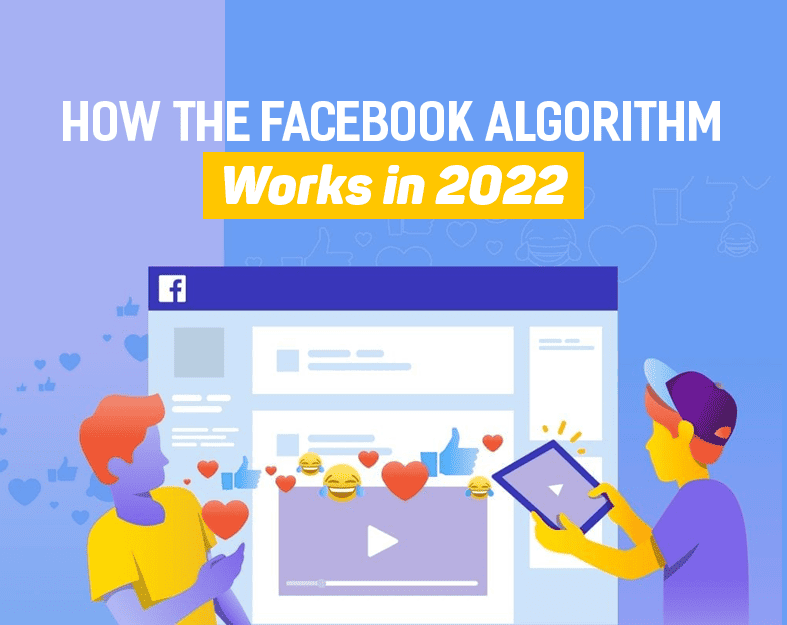Facebook’s algorithm. Whether you love it or despise it, you must comprehend it in order to sell your business on the world’s greatest social network.
The typical organic Facebook Page post has 0.07 percent engagement. To improve that for your brand, you must learn how to signal the algorithm. You want it to recognize that your material is important, real, and worthy of being served up in the feeds of your followers.
What is the Facebook algorithm?
The Facebook algorithm still dictates which posts users see every time they check their Facebook feed, and in what order those posts appear, in 2022 or any other year.
Facebook algorithm evaluate every post. It assesses postings and then organizes them for each individual user in decreasing, non-chronological order of interest. This procedure occurs every time one of the 2.9 billion users refreshes their feed.
We don’t know how the Facebook algorithm determines what to show users (and what not to show people). But we do know that, like any social media recommendation algorithms, one of its purposes is to keep users on the network so they can see more advertisements.
In reality, Facebook drew criticism in 2021 because its algorithm prioritized contentious material. Controversy frequently generates the most participation and can even lead to “compulsive use” of the site.
Even as early as 2018, skeptics worried that the algorithm will increase indignation, hostility, and political polarization while encouraging disinformation and questionable content.
According to Facebook, the algorithm is all about assisting users in “discovering new material and connecting with the topics they care about the most,” while “keeping spam and misleading information at bay.” As you’ll see below, recent Facebook algorithm tweaks have sought to address content and privacy issues.
A brief history of the Facebook algorithm
The Facebook algorithm is flexible. Meta has a whole staff dedicated to artificial intelligence and machine learning. One aspect of their effort is to enhance the algorithms that connect Facebook users with the most relevant material.
Algorithm ranking signals have been added, deleted, and their relevance has been changed throughout time. What people want to see determine everỷhing.
Here are some of the more important developments in the evolution of the Facebook algorithm.
- 2018: Facebook’s new algorithm promotes “posts that stimulate important conversations and connections.” Organic material from Pages was preferred over posts from friends, family, and Facebook Groups. To signal value to the algorithm, brands would now need to acquire a lot more engagement.
- 2019: Facebook promotes “high-quality, original content” that keeps people viewing for more than one minute, particularly video that retains viewers’ interest for more than three minutes. Facebook also begins to prioritize material from “close friends”: those with whom people interact the most. The tool “Why am I seeing this post?” is introduced.
- 2020: Facebook discloses certain algorithm insights to assist consumers understand how it delivers content and allows people to take control of their data to provide greater feedback to the algorithm. The algorithm begins to assess the trustworthiness and quality of news pieces in order to promote verified information rather than falsehoods.
- 2021: Facebook reveals greater information about its algorithm and allows users broader access to their data. Here’s their algorithm explanation for 2021.
How the Facebook algorithm works in 2022
So, where does this all leave us in 2022? First and foremost, News Feed is no longer available. Feed is simply what you see as you navigate through Facebook.
According to Facebook, Feed “offers you important and useful news.” As of 2022, the Facebook algorithm uses three primary ranking signals to determine what such articles could be:
- Who posted it: You’re more likely to see material from people and businesses with whom you interact.
- Type of content: If you engage with video the most, you’ll see more of it. You will view more photographs if you interact with them. You get the picture.
- Interactions with the post: The feed will highlight posts with a high level of interaction, particularly from individuals you connect with frequently.
To decide where a post shows in your feed, five major signals are the criterion for evaluation.
Facebook also provides users with choices for training the algorithm and customizing their feed:
Favorites:
Users can add up to 30 individuals and pages to Favorites (formerly known as “See First”). Posts from these accounts will be prioritized in the Feed. To access Favorites, go to Facebook’s top right and select the down arrow, then Settings & Privacy, and finally News Feed Preferences.
Options for in-feed:
When you click on any post, you’ll see the option I don’t want to see this. Then choose Hide post to notify Facebook that you want fewer posts of that type in your Feed. Hide ad is the similar option on advertising. Facebook will then present you with a number of alternatives for explaining why you wish to conceal the ad. This will assist Facebook in determining which kind of advertising you like to hear from and which you prefer to avoid.
Finally, Facebook will delete content that violates its Community Standards. They may also “delete or limit audiences for specific types of sensitive content,” such as nudity, violence, and violent content.

